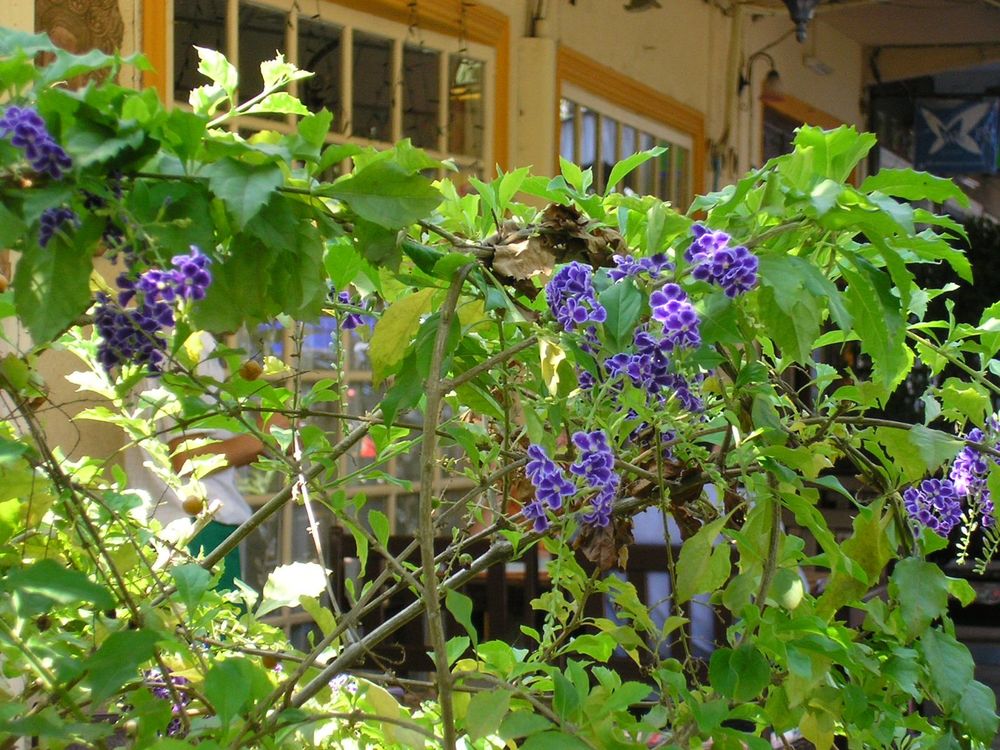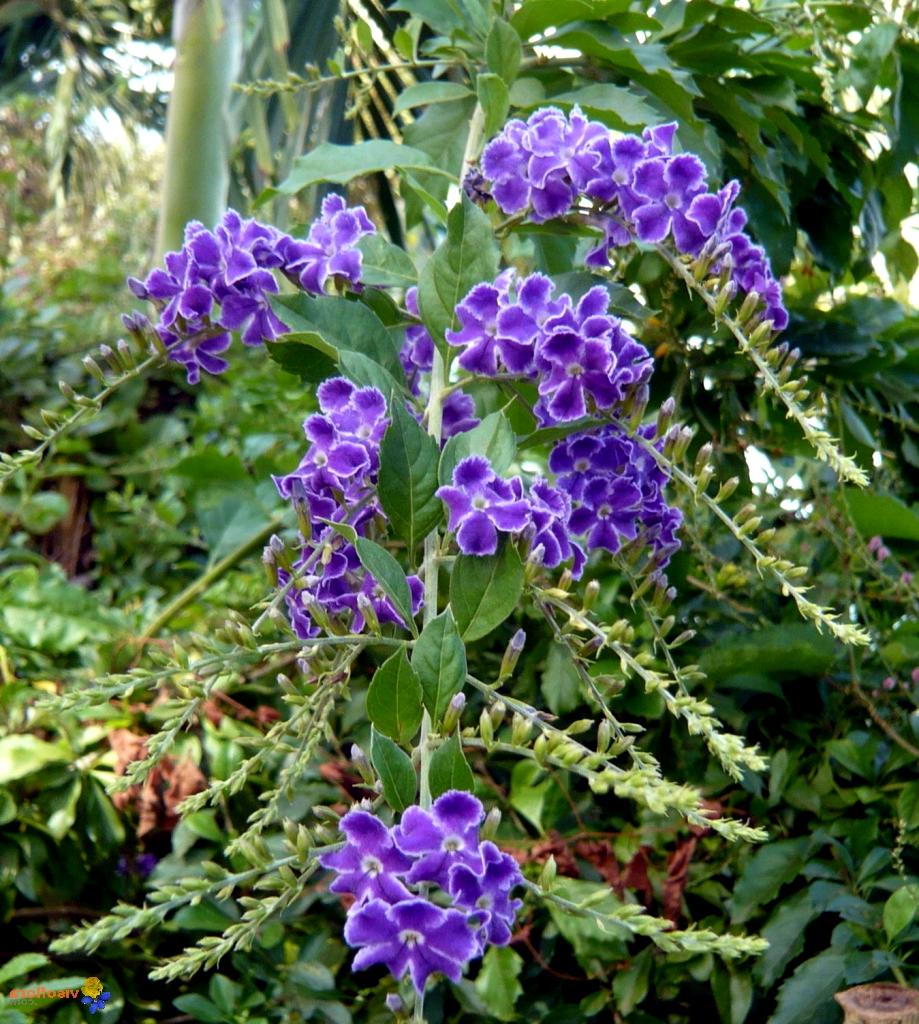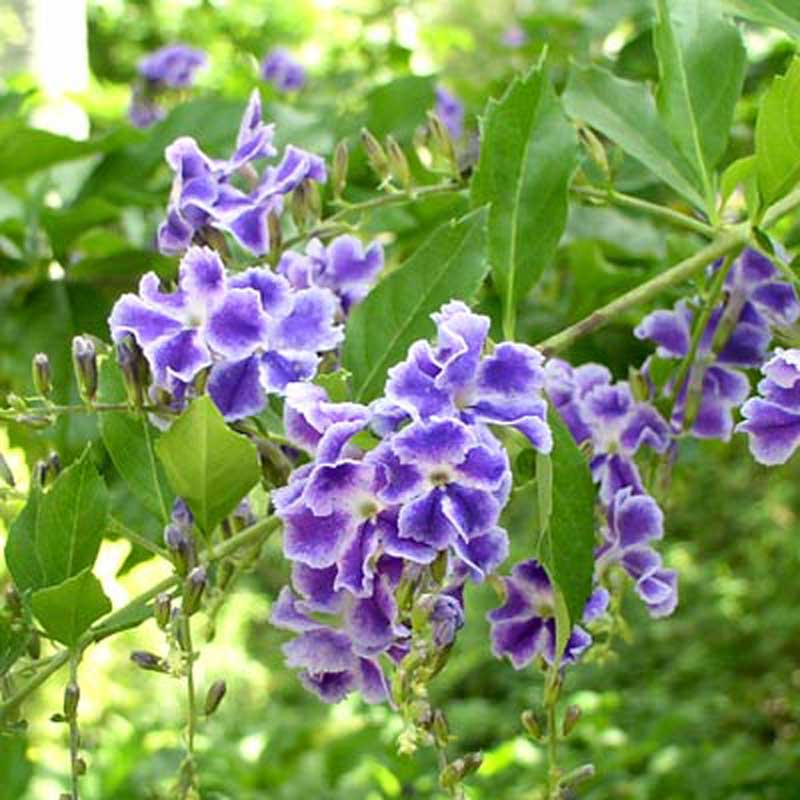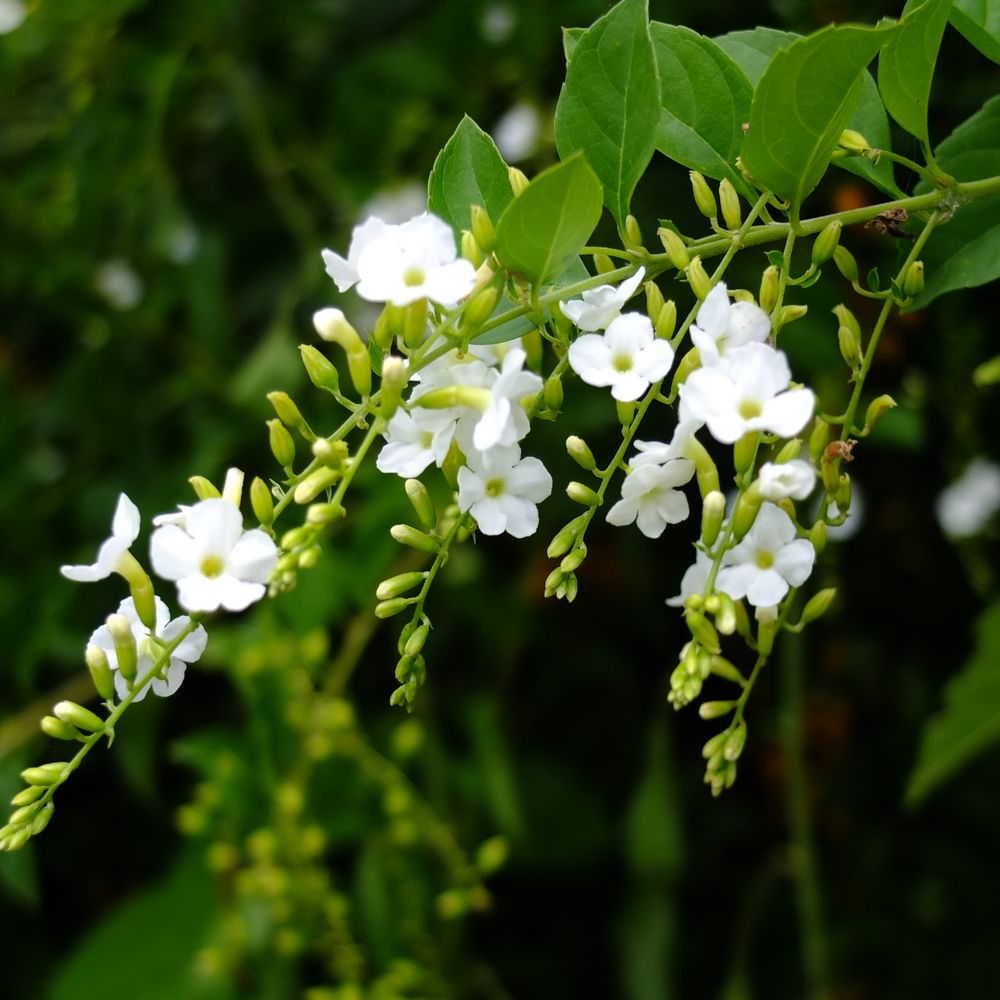You could not fail to notice the Cayenne vanilla tree that is increasingly found in gardens in Laos as in the majority of hot countries. It is remarkable for its compact, very spread out habit, falling in numerous branches more or less flowered of a strong purple. This thorny shrub in the wild state is inerme in culture; its sarmentose branches carry small simple, opposite, elliptic to oval leaves, with notched margin. The flowering is done in more or less long clusters which leave at the axis of the branches; the small tubular flowers have 5 slightly unequal petals, most often blue or purple, sometimes white; their edge and the center of the corolla are lighter. The fruits are small ovoid drupes of a beautiful bright orange-yellow that often cohabit with the flowers. They are toxic for the man but make the feast of the birds from where the English name of the plant Pigeon-Berry.
The flowers give off a light vanilla scent and as this shrub is native to Central America, the French call it Cayenne vanilla or vanillier marron in the West Indies. Its scientific name Duranta was given in memory of the Italian physician-botanist Castor Durante (1529 – 1590) who was one of the first in Europe to make a herbarium of exotic plants. The Lao people in the cities who know this plant well call it, like the Thai, Fongsamouth, this name having been chosen, no doubt by the horticulturists, according to criteria that we do not know.
However, our neighbors have developed an interesting use for Duranta: a handful of leaves are put in ornamental ponds or water basins as an insecticide against mosquito larvae.
Duranta repens is an ornamental shrub that can be planted alone, in a bed or trellised against a wall; it is also used in hedges. To have a bushy plant, with flowers and fruits mixed, it is necessary to prune it often and to give it an important sun exposure.
Vous n’avez pas pu ne pas remarquer le vanillier de Cayenne que l’on rencontre de plus en plus dans les jardins au Laos comme dans la plupart des pays chauds. Il est remarquable par son port compact, très étalé, retombant en de nombreux rameaux plus ou moins fleuris d’un violet soutenu. Cet arbuste épineux à l’état sauvage est inerme en culture; ses branches sarmenteuses portent de petites feuilles simples, opposées, elliptiques à ovales, à marge dentelée. La floraison se fait en grappes plus ou moins longues qui partent à l’axe des rameaux; les petites fleurs tubulaires ont 5 pétales légèrement inégaux, le plus souvent bleus ou violets, parfois blancs; leur bordure et le centre de la corolle sont plus clairs. Les fruits sont de petites drupes ovoïdes d’un beau jaune orangé brillant qui cohabitent souvent avec les fleurs. Ils sont toxiques pour l’homme mais font le régal des oiseaux d’où le nom anglais de la plante Pigeon-Berry.
Les fleurs dégagent un léger parfum de vanille et comme cet arbuste est originaire d’Amérique centrale les Français le nomment vanillier de Cayenne ou vanillier marron aux Antilles. Son nom scientifique Duranta lui a été donné en souvenir du médecin-botaniste italien Castor Durante (1529 – 1590) qui a été l’un des premiers en Europe à faire un herbier de plantes exotiques. Les Lao des villes qui connaissent bien cette plante la nomment, comme les Thaï, Fongsamouth ce nom ayant été choisi, sans doute par les horticulteurs, en fonction de critères que nous ignorons.
Cependant, chez nos voisins s’est développé un usage intéressant de Duranta: on met dans les bassins d’agrément ou dans les vasques d’eau une poignée de feuilles comme insecticide contre les larves de moustiques.
Duranta repens est un arbuste ornemental que l’on peut planter seul, ou dans un massif ou encore palisser contre un mur; il entre aussi dans la confection de haies. Pour avoir une plante bien touffue, avec fleurs et fruits mêlés, il faut la tailler souvent et lui donner une exposition solaire importante.




You could not fail to notice the Cayenne vanilla tree that is increasingly found in gardens in Laos as in the majority of hot countries. It is remarkable for its compact, very spread out habit, falling in numerous branches more or less flowered of a strong purple. This thorny shrub in the wild state is inerme in culture; its sarmentose branches carry small simple, opposite, elliptic to oval leaves, with notched margin. The flowering is done in more or less long clusters which leave at the axis of the branches; the small tubular flowers have 5 slightly unequal petals, most often blue or purple, sometimes white; their edge and the center of the corolla are lighter. The fruits are small ovoid drupes of a beautiful bright orange-yellow that often cohabit with the flowers. They are toxic for the man but make the feast of the birds from where the English name of the plant Pigeon-Berry.
The flowers give off a light vanilla scent and as this shrub is native to Central America, the French call it Cayenne vanilla or vanillier marron in the West Indies. Its scientific name Duranta was given in memory of the Italian physician-botanist Castor Durante (1529 – 1590) who was one of the first in Europe to make a herbarium of exotic plants. The Lao people in the cities who know this plant well call it, like the Thai, Fongsamouth, this name having been chosen, no doubt by the horticulturists, according to criteria that we do not know.
However, our neighbors have developed an interesting use for Duranta: a handful of leaves are put in ornamental ponds or water basins as an insecticide against mosquito larvae.
Duranta repens is an ornamental shrub that can be planted alone, in a bed or trellised against a wall; it is also used in hedges. To have a bushy plant, with flowers and fruits mixed, it is necessary to prune it often and to give it an important sun exposure.
Vous n’avez pas pu ne pas remarquer le vanillier de Cayenne que l’on rencontre de plus en plus dans les jardins au Laos comme dans la plupart des pays chauds. Il est remarquable par son port compact, très étalé, retombant en de nombreux rameaux plus ou moins fleuris d’un violet soutenu. Cet arbuste épineux à l’état sauvage est inerme en culture; ses branches sarmenteuses portent de petites feuilles simples, opposées, elliptiques à ovales, à marge dentelée. La floraison se fait en grappes plus ou moins longues qui partent à l’axe des rameaux; les petites fleurs tubulaires ont 5 pétales légèrement inégaux, le plus souvent bleus ou violets, parfois blancs; leur bordure et le centre de la corolle sont plus clairs. Les fruits sont de petites drupes ovoïdes d’un beau jaune orangé brillant qui cohabitent souvent avec les fleurs. Ils sont toxiques pour l’homme mais font le régal des oiseaux d’où le nom anglais de la plante Pigeon-Berry.
Les fleurs dégagent un léger parfum de vanille et comme cet arbuste est originaire d’Amérique centrale les Français le nomment vanillier de Cayenne ou vanillier marron aux Antilles. Son nom scientifique Duranta lui a été donné en souvenir du médecin-botaniste italien Castor Durante (1529 – 1590) qui a été l’un des premiers en Europe à faire un herbier de plantes exotiques. Les Lao des villes qui connaissent bien cette plante la nomment, comme les Thaï, Fongsamouth ce nom ayant été choisi, sans doute par les horticulteurs, en fonction de critères que nous ignorons.
Cependant, chez nos voisins s’est développé un usage intéressant de Duranta: on met dans les bassins d’agrément ou dans les vasques d’eau une poignée de feuilles comme insecticide contre les larves de moustiques.
Duranta repens est un arbuste ornemental que l’on peut planter seul, ou dans un massif ou encore palisser contre un mur; il entre aussi dans la confection de haies. Pour avoir une plante bien touffue, avec fleurs et fruits mêlés, il faut la tailler souvent et lui donner une exposition solaire importante.








You could not fail to notice the Cayenne vanilla tree that is increasingly found in gardens in Laos as in the majority of hot countries. It is remarkable for its compact, very spread out habit, falling in numerous branches more or less flowered of a strong purple. This thorny shrub in the wild state is inerme in culture; its sarmentose branches carry small simple, opposite, elliptic to oval leaves, with notched margin. The flowering is done in more or less long clusters which leave at the axis of the branches; the small tubular flowers have 5 slightly unequal petals, most often blue or purple, sometimes white; their edge and the center of the corolla are lighter. The fruits are small ovoid drupes of a beautiful bright orange-yellow that often cohabit with the flowers. They are toxic for the man but make the feast of the birds from where the English name of the plant Pigeon-Berry.
The flowers give off a light vanilla scent and as this shrub is native to Central America, the French call it Cayenne vanilla or vanillier marron in the West Indies. Its scientific name Duranta was given in memory of the Italian physician-botanist Castor Durante (1529 – 1590) who was one of the first in Europe to make a herbarium of exotic plants. The Lao people in the cities who know this plant well call it, like the Thai, Fongsamouth, this name having been chosen, no doubt by the horticulturists, according to criteria that we do not know.
However, our neighbors have developed an interesting use for Duranta: a handful of leaves are put in ornamental ponds or water basins as an insecticide against mosquito larvae.
Duranta repens is an ornamental shrub that can be planted alone, in a bed or trellised against a wall; it is also used in hedges. To have a bushy plant, with flowers and fruits mixed, it is necessary to prune it often and to give it an important sun exposure.
Vous n’avez pas pu ne pas remarquer le vanillier de Cayenne que l’on rencontre de plus en plus dans les jardins au Laos comme dans la plupart des pays chauds. Il est remarquable par son port compact, très étalé, retombant en de nombreux rameaux plus ou moins fleuris d’un violet soutenu. Cet arbuste épineux à l’état sauvage est inerme en culture; ses branches sarmenteuses portent de petites feuilles simples, opposées, elliptiques à ovales, à marge dentelée. La floraison se fait en grappes plus ou moins longues qui partent à l’axe des rameaux; les petites fleurs tubulaires ont 5 pétales légèrement inégaux, le plus souvent bleus ou violets, parfois blancs; leur bordure et le centre de la corolle sont plus clairs. Les fruits sont de petites drupes ovoïdes d’un beau jaune orangé brillant qui cohabitent souvent avec les fleurs. Ils sont toxiques pour l’homme mais font le régal des oiseaux d’où le nom anglais de la plante Pigeon-Berry.
Les fleurs dégagent un léger parfum de vanille et comme cet arbuste est originaire d’Amérique centrale les Français le nomment vanillier de Cayenne ou vanillier marron aux Antilles. Son nom scientifique Duranta lui a été donné en souvenir du médecin-botaniste italien Castor Durante (1529 – 1590) qui a été l’un des premiers en Europe à faire un herbier de plantes exotiques. Les Lao des villes qui connaissent bien cette plante la nomment, comme les Thaï, Fongsamouth ce nom ayant été choisi, sans doute par les horticulteurs, en fonction de critères que nous ignorons.
Cependant, chez nos voisins s’est développé un usage intéressant de Duranta: on met dans les bassins d’agrément ou dans les vasques d’eau une poignée de feuilles comme insecticide contre les larves de moustiques.
Duranta repens est un arbuste ornemental que l’on peut planter seul, ou dans un massif ou encore palisser contre un mur; il entre aussi dans la confection de haies. Pour avoir une plante bien touffue, avec fleurs et fruits mêlés, il faut la tailler souvent et lui donner une exposition solaire importante.


